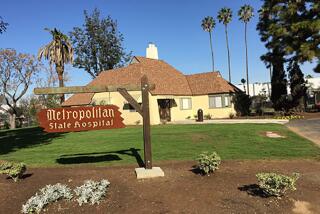Campus Planners Told to Put Academics First
- Share via
A Cal State University trustee said Monday that efforts to convert Camarillo State Hospital into a four-year college should focus more on building a solid academic program rather than money-making ventures to finance the school well into the next century.
During a meeting to review the development of Ventura County’s first public university, planners said they were exploring ways to expand the size of the school so it could handle more than 3,000 students after the year 2005.
One idea was to swap a university-owned lemon orchard near Central Avenue for 280 acres south of Camarillo that could be leased or developed.
But while planners were in the middle of a presentation on that proposal, trustee William D. Campbell piped up, suggesting that they were getting ahead of themselves.
Campbell told planners they should be paying more attention to fashioning an academic plan that would help get the Ventura County campus off the ground and set it apart from others in the state.
“I think we really need to back into this with a strong academic program,” said Campbell, adding that he favors retaining the Camarillo lemon orchard for academic-related uses.
“It really needs to be a comprehensive plan to be effective and get political support,” Campbell said. “I don’t think you should be spending so much effort . . . figuring out how to shuffle land around like we’re playing Monopoly.”
Taking a cue from Campbell, Cal State planners said their focus now is likely to shift somewhat.
While conceding that they need to focus on an academic plan to launch the university, they cautioned that they needed to keep an eye on long-term finances.
“I don’t think this is an issue that will go away,” said Richard West, Cal State’s senior vice chancellor for finances.
As it stands, planners have suggested that the state hospital could not be converted into a university unless nearly the entire campus was dedicated to a range of income-generating ventures.
Those include the creation of a sprawling retirement community on the outskirts of the site and an aggressive leasing program that initially would put most of the sprawling campus in the hands of private businesses.
By the year 2005, those and other projects would generate an estimated $6.1 million a year, enough to renovate buildings to handle 3,000 students.
But Cal State planners had been aiming beyond that, knowing they will need to raise more cash to continue to expand the college and its student population.
“I think this may take the pressure off us from a financial perspective,” said Mary Stephens, executive project manager for the developing campus. “I think what they’ve told us is not to ignore any options, but that [development] should not be the prime focus, it should not drive the planning process.”
What’s driving the process now is time. Cal State officials will meet with trustees throughout the summer to provide progress reports.
And they hope to come before the full board, perhaps as early as September, to lay out the entire plan to convert the mental hospital into a university.
With so much attention being paid to the tricky finances, some trustees are worried that a larger message is being lost in the process.
Ventura County is the largest county in the state without a four-year public university. And while the county has had a college campus on the drawing board for three decades, it has been unable to turn the concept into a reality.
“We need to look at what the potential demand is in Ventura County,” said trustee Jim Considine. “I feel that need has kind of gotten lost with the focus on the physical plant and lots of other things.”
More to Read
Sign up for Essential California
The most important California stories and recommendations in your inbox every morning.
You may occasionally receive promotional content from the Los Angeles Times.










